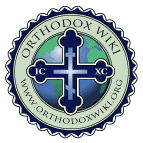Lego Church
In the winter, in the north, it is easy enough to get bored. However, with the neighbors' Lego bin, I found myself putting together pieces of an Orthodox Byzantine church. I decided to go as far as I could, and stole all the base pieces and set to work. After a few months of letting it sit around the apartment, I took pictures (thanks to Jenny). After a few weeks of letting the pictures linger around in the digital ether, I uploaded, sorted, and labelled.
All pictures are copyright by Magda Andronache, and I would appreciate it if you let me know before you use them.
Here is an overview of the church:

The first thing I do when I go to church is venerate the icons.

Now let's start to go around the church in a clockwise circle.


***N.B. Peterbird says that after this year, only monks in the Greek Archdiocese will wear the kalimavki. It is a relatively recent invention, and comes from Turkey. Monks' kalimavki have no brim, while deacons' kalimavki do have a brim.









If you would like to see a tidier-looking Orthodox Lego Church, this site will also tell you how to serve a hierarchical Divine Liturgy.
All pictures are copyright by Magda Andronache, and I would appreciate it if you let me know before you use them.
Here is an overview of the church:

The first thing I do when I go to church is venerate the icons.
Now let's start to go around the church in a clockwise circle.


***N.B. Peterbird says that after this year, only monks in the Greek Archdiocese will wear the kalimavki. It is a relatively recent invention, and comes from Turkey. Monks' kalimavki have no brim, while deacons' kalimavki do have a brim.






If you would like to see a tidier-looking Orthodox Lego Church, this site will also tell you how to serve a hierarchical Divine Liturgy.



2 Comments:
This is incredible, Magda! Like Philippa, I can definitely see the Church School applications, and like Laura, the mom ones!
I'm going to send this to my kids!
Hi! I'm Phyllis Meshel Onest, M.Div,Holy Cross 1977 and DRE for the Met. of Pittsburgh. THIS IS GREAT!!! I would like to share this with others on my website www.phyllisonest.com with your permission and full credit. What a wonderful project. My daughter Maria [now24] has tons of Legos. Didn't think of using them this way
Post a Comment
<< Home